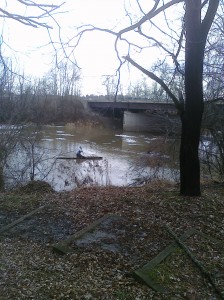 It was a brilliantly sunshiny day, and the temperature was around 37 degrees F, so Jim and I decided to go paddling in a part of the Genesee River near his place that was “open” (for some value of open). Our usual partner in crime, Stephen B, was busy with family stuff. When I arrived, the floes were pretty dense, very thick, and roaring down the river at about 1.5 miles per hour. I kind of wish I’d brought my Looksha instead of banging up my Thunderbolt. The Looksha is a stronger, heavier boat, plus if I’m going to damage a boat, I’d rather damage the one I’m not going to be racing. Jim paddles a big heavy downriver boat for just that reason.
It was a brilliantly sunshiny day, and the temperature was around 37 degrees F, so Jim and I decided to go paddling in a part of the Genesee River near his place that was “open” (for some value of open). Our usual partner in crime, Stephen B, was busy with family stuff. When I arrived, the floes were pretty dense, very thick, and roaring down the river at about 1.5 miles per hour. I kind of wish I’d brought my Looksha instead of banging up my Thunderbolt. The Looksha is a stronger, heavier boat, plus if I’m going to damage a boat, I’d rather damage the one I’m not going to be racing. Jim paddles a big heavy downriver boat for just that reason.
Trying to get in on the slippery bank, I managed to soak both feet, which is not good. Then it was hard to get turned upstream without going out into the main flow of floes. But we were able to sneak up stream by staying tucked in close to the near bank. Then after a while the ice jammed in on our side of the river, but the other side was very clear of ice for over half the width of the river. We ferry over by turning perpendicular to the current and allowing ourselves to drift downstream as we pick our way across. We ended up repeating this process a few times as the river snaked back and forth. If you choose the right point to cross in a gap between floes, you don’t even lose much paddling time.
The banks are high, and so we’re enjoying the bright sunshine but are protected from whatever wind there might be. It didn’t take long for my feet to warm up, and with my PFD on I didn’t even bother with the anorak I’ve been wearing on the colder days. (I got a really nice paddling jacket for Christmas, but it was one size too small so I’ll have to wait before I get to paddle in it.)
With the river flowing so fast, we paddled up for about 55 minutes, and down for about 25 minutes. On the way down, my feet started to get cold again – Jim said that cold feet are often the deciding factor for how long you can paddle in the cold, and he recommended that I get some neoprene wet suit boots or something. But even cold feet couldn’t diminish my feeling of how great this was. Even a bad day paddling is better than a good day in the gym, and this was a good day paddling.

Paul,
I see that you posted a question regarding NYMCRA kayak points on the NYMCRA forum. Typical to my experiences with forums, the ____ won’t let me log-in so I’m posting a reply here:
The adjustment minutes are based on the paddlers age and the boat class raced. I did a statistical analysis of the performance differential of the races from 2003 through 2008 to come up with the formula. As it works, there is a 10 second per mile reduction in finish time (only for points) for over 50 versus under fifty. There is a 12 second per mile reduction for touring class and a 20 second per mile reduction for recreation class. There is a 15 second per mile addition for K2. These adjustments allow all boat classes to compete for the points championship which never occurred in the past. It also allows for persons to switch classes but still be eligible for the championship as long as they paddled a total of 5 races no matter the class of any race. There is one class I have yet to determine a handicap for and that is K2 mixed but, fortunately, that class is not often seen in points races.
As an example of how this works, Dan ended up with 90 points at Long Lake because he paddled an unlimited class boat (V10 – no points adjustment) and was over fifty (10 seconds per mile reduction). I think Bill Feeney (may be mistaken – info is on other computer) got the 100 pts because he paddled touring class (EFT – 12 seconds per mile reduction in finish time) and is over 50 for an additional 10 seconds per mile reduction. Bill’s finish time combined with the two adjustments (versus one for Dan) gave him a faster adjusted time and 100 pts. That is how the system works to equalize the competition over all classes.
There were more new paddlers in the 2009 NYMCRA points series so an additional stat analysis of the handicap will be performed to ensure that the system is equalizing the classes at the 95% confidence limits. I should have that done by the January race director’s meeting. I do not anticipate much adjustment at this time but do hope to have a mixed handicap adjustment by then.
Send me an e-mail if you have more questions about the handicap for the kayak point series.>>>>>Scott